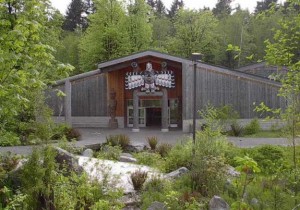What is The Longhouse Ethnobotanical Garden?
 The Longhouse Ethnobotanical Garden features plants that are native to the Pacific Northwest. It surrounds the “Welcome House” Longhouse at The Evergreen State College. Plantings are arranged in habitat areas reflecting the conditions in which they would naturally occur.
The Longhouse Ethnobotanical Garden features plants that are native to the Pacific Northwest. It surrounds the “Welcome House” Longhouse at The Evergreen State College. Plantings are arranged in habitat areas reflecting the conditions in which they would naturally occur.
When was The Longhouse Ethnobotanical Garden created?
The Longhouse, itself, was designed and built in 1994 by Seattle-based architects, Jones and Jones. A funding shortfall, however, prevented installation of the landscape plans. At this time, students of adjunct faculty member, Marja Eloheimo, were helping to create two off-campus ethnobotanical gardens. In a conversation between Eloheimo and Colleen (Ray) Jollie, the first Longhouse director, the idea to create an ethnobotanical garden at the Longhouse arose. Eloheimo’s students began development in 1995.
What are the purposes of The Longhouse Ethnobotanical Garden?
The Longhouse Ethnobotanical Garden has five purposes. These are:
-To honor, preserve and better understand native plants of the Pacific Northwest.
In this garden, we show the plants respect in several ways. For example, at least 80% of the plants present have been salvaged from development sites. In order to plant these and other plants in suitable locations, we deepen our understanding of their growth needs and habitat affinities. We include name signs to help visitors learn to recognize and identify the plants.
-To acknowledge the close traditional relationships between Native People and native plants.
A garden of this type would not have been traditional in this region. Nor would many of the plants present have occurred at a traditional Longhouse site. However, the location of The Longhouse Ethnobotanical Garden draws attention to how deeply and fully First Peoples have understood their plant relatives, and with what great care they interacted with them. Additionally, plant names in local Indigenous languages (including Lushootseed, Twelshootseed, Twana and Chehalis) are included whenever possible on plant identification signs. This purpose supports the type of learning that situations understanding of traditional plant knowledge within larger cultural contexts.
– To provide a living resource for learning.
-To provide opportunities for interdisciplinary, inter-community and intercultural exchange and collaboration.
-To restore and enhance the landscape at the Longhouse.
